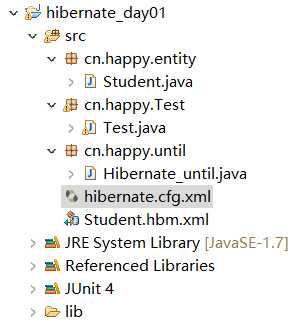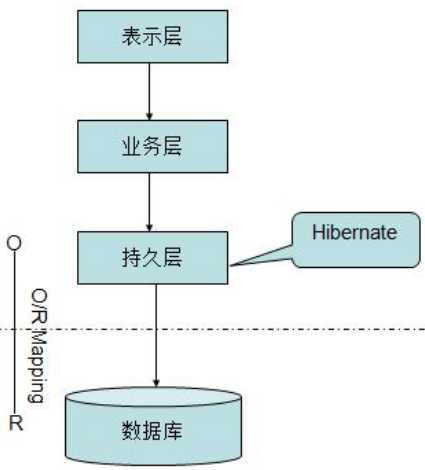标签:
l 优秀的Java 持久化层解决方案 (DAO)
l 主流的对象—关系映射工具产品
l 简化了JDBC 繁琐的编码
l 将数据库的连接信息都存放在配置文件
l 自己的ORM框架
l 一定要手动实现Hibernate(模拟Hibernate实现)
一:创建一个java project项目
如下图

2:创建一个大配置文件
<?xml version="1.0" encoding="UTF-8"?> <!DOCTYPE hibernate-configuration PUBLIC "-//Hibernate/Hibernate Configuration DTD 3.0//EN" "http://www.hibernate.org/dtd/hibernate-configuration-3.0.dtd"> <hibernate-configuration> <session-factory> <!-- Database connection settings 数据库连接设置--> <!-- 驱动类 --> <property name="connection.driver_class">oracle.jdbc.OracleDriver</property><!-- 数据库驱动语言 --> <property name="connection.url">jdbc:oracle:thin:@localhost:1521:orcl</property><!-- 数据库连接字符串 --> <property name="connection.username">Y2162</property><!-- 用户名 --> <property name="connection.password">1</property><!-- 密码 --> <!-- SQL dialect (sql的方言)--> <property name="dialect">org.hibernate.dialect.Oracle10gDialect</property><!-- 通过oracle数据库的版本规定sql方言 --> <!-- Echo all executed SQL to stdout 在控制台打印后台的sql语句--> <property name="show_sql">true</property><!-- 可省,展示生成的sql语句 --> <!-- 格式化显示sql --> <property name="format_sql">true</property><!-- 可省,将展示出的sql语句格式化--> <!-- Drop and re-create the database schema on startup 序列化--> <property name="hbm2ddl.auto">update</property><!-- 数据库的建表语句首选create,之后选择update --> <mapping resource="Student.hbm.xml" /><!-- 关联小配置文件 --> </session-factory> </hibernate-configuration>
继而创建一个小配置文件
<?xml version="1.0" encoding="UTF-8"?> <!DOCTYPE hibernate-mapping PUBLIC "-//Hibernate/Hibernate Mapping DTD 3.0//EN" "http://www.hibernate.org/dtd/hibernate-mapping-3.0.dtd"> <hibernate-mapping package="cn.happy.entity"><!-- 关联哪个包下的类 --> <class name="Student" table="STUDENT"><!-- 符合一类对应一表 --> <id name="sid" column="SID"><!-- 生成主键(唯一标识) --> <!-- 主键生成策略:native: native:如果后台是Oracle 后台是MySQL,自动应用自增 --> <generator class="increment" /> </id> <property name="name" type="string" column="NAME" /> <property name="age" type="int" column="AGE"/> </class> </hibernate-mapping>

编写程序的时候,以面向对象的方式处理数据
保存数据的时候,却以关系型数据库的方式存储
三:Test类中的测试数据
package cn.happy.Test; import org.hibernate.Session; import org.hibernate.SessionFactory; import org.hibernate.Transaction; import org.hibernate.cfg.Configuration; import org.junit.After; import org.junit.Before; import cn.happy.entity.Student; import cn.happy.until.Hibernate_until; public class Test { public static void main(String[] args) { //addAll(); //delete(); find(); } public static void addAll() { Student stu=new Student(); stu.setSid(1); stu.setAge(18); stu.setName("我是狗"); //获取session对象 Session session = Hibernate_until.getSession(); //开启事务 Transaction tran = session.beginTransaction(); //hibernate保存 session.save(stu); System.out.println("成功保存!"); tran.commit(); Hibernate_until.closeSession(); } public static void delete() { //打开session Session session = Hibernate_until.getSession(); //开始一个事务 Transaction tx=session.beginTransaction(); //获取部门的对象 Student stu=(Student)session.get(Student.class, new Integer(1)); //删除对象(持久化操作) if(stu!=null) { session.delete(stu); } try { //提交事务 tx.commit(); System.out.println("删除成功"); } catch (Exception e) { //回滚事务 tx.rollback(); System.out.println("删除回滚"); } Hibernate_until.closeSession(); } public static void update() { Session session = Hibernate_until.getSession(); //开始一个事务 Transaction tx=session.beginTransaction(); //获取部门的对象 Student stu=(Student)session.get(Student.class, new Integer(1)); //删除对象(持久化操作) if(stu!=null) { stu.setName("武松"); session.update(stu); } try { //提交事务 tx.commit(); System.out.println("删除成功"); } catch (Exception e) { //回滚事务 tx.rollback(); System.out.println("删除回滚"); } Hibernate_until.closeSession(); } public static void find() { Session session = Hibernate_until.getSession(); //获取部门的对象 Student stu=(Student)session.get(Student.class, new Integer(2)); System.out.println(stu); } }
通过以上代码,我们就能轻松的使用框架向db端操作数据了
标签:
原文地址:http://www.cnblogs.com/chimingyang/p/5815179.html